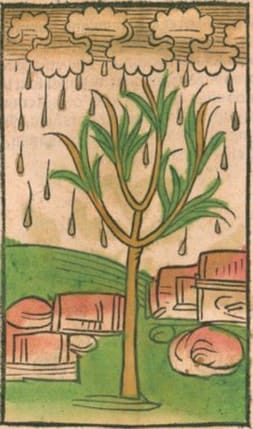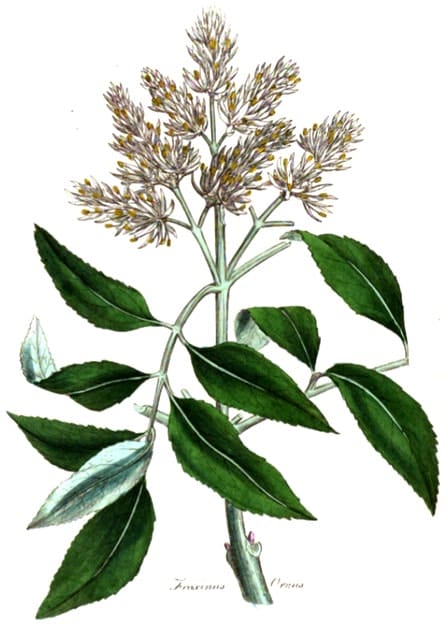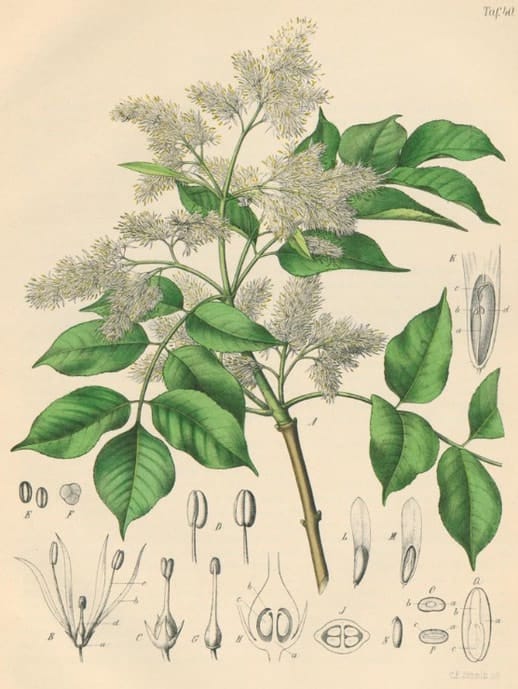Manna
 Ortus Sanitatis, Meydenbach, 1491
Ortus Sanitatis, Meydenbach, 1491 Fraxinus ornus (Flowering Ash)
Fraxinus ornus (Flowering Ash)Medical Botany, Woodville, Hooker, Vol. 3, 1832
 Atlas der Officinellen Pflanzen, Berg & Schmidt, Leipzig, 1893
Atlas der Officinellen Pflanzen, Berg & Schmidt, Leipzig, 1893Botanical name:
Fraxinus ornus (Flowering Ash, Manna Ash) and F. rotundifolia
Fraxinus excelsior and other species also supply some Manna
Manna has been collected from several other plants, used synonymously:
- Persian or Alhagi Manna from Alhagi camelorum (Hedysarum alhagi)
- Briancon Manna, Manna laricina: Manna from the leaves of Larix europea (Pinus Larix) (Coniferae).
- Tamarisk Manna, from Tamarix mannifera and T. gallica (Tamiricace)
- Armenian manna is derived from Quercus Persica, and Quercus vallonea (Cupuliferfe)
- Australian manna, from Eucalyptus viminalis (Myrtacese);
Parts used:
Secreted gum-resin
Several kinds of Manna are distinguished:
- Flake Manna (Manna canellata): whitish, pale-yellow or reddish pieces hollow on one side, convex on the other
- Tears of Manna (Manna lacrymata): smaller fragments of the above are called tears
- Common Manna (Manna communis): round cakes or oblong pieces, yellowish, soft to touch
- Fat Manna (Manna crassa, Manna pinguis): very moist, yellowish, soft with much admixture of foreign matter
- Mastichina (Manna difronde): that which exudes spontaneously in grains the size of wheat (rare)
Temperature & Taste:
Cool, moist. Sweet
Classifications:
Laxative, Purgatives and Cathartics
Preparers and Purgers of Bile
Uses:
1. Clears Heat, Loosens the Bowels:
-suitable as a laxative for children and pregnant women
-gently purges Bile Humor
2. Harmonises the Stomach:
-settles and soothes the Stomach, opens and cleanse Stomach
-corrects some irritant medicines like Cyclamen
-helps clears Phlegm and Damp
Dose:
In adults: 15–30 grams; in children: 2–15 grams, usually added to decoctions of some other suitable vehicle. Culpeper said a one year old child can take 1 oz. of it in warm milk, where it will melt like sugar.
Comment:
Culpeper said it is very good for those who are constipated to use it in their drinks instead of sugar.
Correctives:
Mesue listed Thyme, Ammi, Cardamon to correct and facilitate purgation.
Substitute:
1. Cassia Fistula;
2. Licorice extract
3. Fenner, in his Complete Formulary (1888) said Grape Sugar may substitute Manna, but is not as good.
Main Combinations:
1. As a mild purgative for Bile, Manna is combined with Cassia Fistula, Rhubarb
2. Obstinate Colic, Manna, Sweet Almond Oil, mixed with Cheicken broth and given.
3. Hemorrhoids: Manna (2 oz.), Potassium sulphate, Potassium nitrate, Sulphur (2 drams each), Honey (sufficient to make an Electuary. (Formulaire Magistral et Memorial Pharmaceutique, 1823)
Major Formulas:
Troches of Camphor (Mesue)
Indian Electuary (Unani)
1. Lohoch (or Linctus) of Manna:
i. Manna (2 oz.), Oil of Almonds (1 oz.). Triturate and mix. (Pharmacopoeia medici practici universalis, Bruxelles, 1817)
ii. Oil of Almonds, Syrup of Marshmallows, Manna (4 parts each), Orange flower-water (1 part), Water (2 parts). Dissolve the Manna in the water with moderate heat; add to the mixed Oil and Syrup and mix well together. (Henri)
iii. Gum Arabic (1 oz.), Oil of Almonds (2 oz.), Decoction of Barley (10 oz.), Manna (1 oz.), Honey (half oz.). Mix.
2. Purgative Potion:
i. Manna (3 oz.), Water (6 oz.). Dissolve. (Ratier)
ii. Manna (2 oz.), water (1 lb.), Cassia Pulp (1 oz.). Mix for 2 doses.
iii. Cream of Tartar (2 drams), Boiling Water (5 oz.), Manna (2 oz.). Dissolve and strain. (Pharmacopoeia Generalis, 1783)
iv. Cassia Pulp (half oz.), Cream of Tartar (1 ½ drams), Manna (2 oz.), Spring Water (5 oz.). Dissolve, strain. (Pharmacopoeia Generalis, 1783)
v. Tamarind pulp (3 oz.), Manna (1 oz.), Camomile Water (9 oz.). Dissolve, strain. (Pharmacopoeia extemporanea, Augustin, 1822)
vi. Manna (1 oz.), Senna, Cream of Tartar, Aniseed (half oz. each), Water (4 lbs.). Infuse half an hour, then boil a little and strain. Dose: 6 oz. (Pharmacopoeia Hispana, 1798)
Cautions:
Generally safe.
1. Not used in cases with Ileus (gastrointestinal atony).
2. Nausea and flatulence may be experienced by sensitive individuals.
3. Not used on an extended basis.
Main Preparations used:
1. Manna Troches:
i. Tragacanth (1 part), White Sugar (96 parts); triturate together and add: Manna (24 parts), Orange flower-water (sufficient) to make a paste to be formed into Troches. (Pharmacopee Usuelle, Louvain, 1821)
ii. Marshmallow root (96 parts), Water (2000 parts); boil for 6 minutes and add Sugar (3000 parts), Manna (192 parts); strain, clarify with an Egg white and add aquaeous extract of Opium (6 parts), Oil of Bergamont (10 parts), Orange flower-water (96 parts).
2. Syrup of Manna:
i. Manna (10 oz.), Spring Water (12 oz.); strain and add White Sugar (1 lb.). Boil to a syrup. (Dispensatorium Pharmaceuticum, 1777)
3. Electuary of Manna:
i. Manna (3 parts), Oil of Almonds (1 part); triturate together and gradually add Syrup of Manna (1 part). Mix. (Pharmacopee Usuelle, Louvain, 1821)
ii. Manna (2 oz.), Fennel water (1 oz.); triturate together without Heat; strain and mix with: Sugar (2 oz.), Florentine Orris (1 dram), Oil of Almonds (1 oz.). Mix. (Pharmacopee Usuelle, Louvain, 1821)
